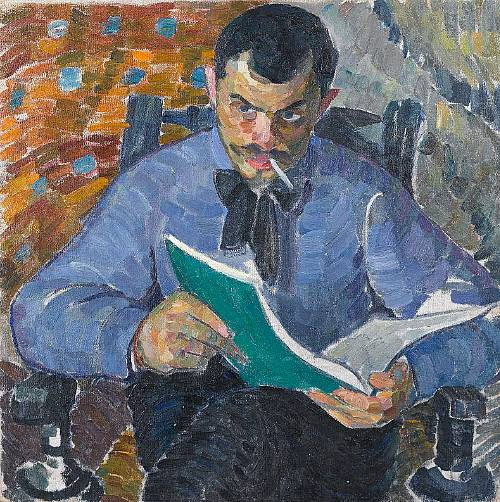|
|
Александр БОГОМАЗОВ
(1880-1930).
Портрет
художника Бурданова.
1912. Масло на холсте.
57.5x57.5 cм (22 3/4 x 22 3/4 in.).
Картина была
выставлена на продажу на аукцион Bonhams,
Sale 14974
- The Russian Sale, 31 May 2007
New Bond Street,
лот No: 83*.
Эстимейт: £200.000 - 300.000
/
$400.000 - 600.000.
Информация об этой работе на сайте аукциона
Bonhams
>>
Reverse of the canvas titled and inscribed in Russian by the
artist's daughter Yaroslava Alexandrovna "Portrait of an actor"/ A
painting by A. K. Bogomazov/ Daughter of the artist Ya. A. Ivanikova
(Bogomazova)'
Footnote:
Provenance:
Estate of the artist;
Modernism Gallery, San Francisco, California;
Private Collection
A striking example of the Ukrainian Futurist's early work, the
present lot's pleasing dynamism betrays the artist's later
Futuristic tendencies, while illustrating the contemporary
influences on his oeuvre.
Professor D.E. Gorbachov, recognized authority on the artist, has
identified the sitter as the Kiev-based artist, Grigorii
Grigor'evich Burdanov and has dated the work to 1911. Little is
published about Burdanov, but it is known that he helped Vrubel in
his work at the Vladimirskiy Cathedral in Kiev. The reverse of the
canvas is inscribed by Yaroslava Alexandrovna, the artist's
daughter, and titled 'Portrait of an actor'. Given the synthesis of
artistic professions at this time (Bogomazov was also a writer on
art theory as well as an artist, while David Burliuk was both an
artist and poet), it is entirely possible that Burdanov was depicted
by Bogomazov in the present lot in the guise of 'actor', as opposed
to that of 'artist'. It is more likely, however, that Yaroslava
Alxandrovna, born in 1917, was not aware of the identity of the
sitter, as she does not name him in the inscription. It may be that
the tome held by Burdanov in the painting is not an actor's script,
but a treatise or manifesto, such as were being published in Kiev
artistic circles at the time (the Burliuk brothers' 1912 A Slap in
the Face of Public Taste, or Bogomazov's Zhivopis' i Elementy,
written in 1914).
Portrait of an actor is integral to the study of the development of
Bogomazov's corpus of work. In this context, it is a Janus-like
indicator of the artist's stylistic progression. Motifs, such as the
loose, post-Pointillist brushstrokes which comprise the background
of the painting, point to an absorption of the style of the Russian
Symbolist, Borisov-Musatov, from whose influence Bogomazov was to
move away when he embraced the latent power of shape and form and
vivified it in the later corpus of his work. Gorbachov notes a
distinct change in the artist's style between the period of
execution of this work, and the Futuristic mantle which Bogomazov
adopted from 1913 onwards.
Ever receptive to the beauty of geometrical forms, Bogomazov's
affinity with this aesthetic is evident in the offered lot in the
vibrant colour scheme employed. The artist harnesses colour as if it
were another dimension; at one remove from convention, whereby light
and shade are used to create the illusion of depth, Bogomazov
applies colours as if they are forms, with a plasticity all their
own. The figure of the sitter sees colour reigned in with a bold,
slim blue line which forms the shirt and the book, while the
different shades of blue applied add a vibrancy to the overall
effect of the colour, imbuing it with texture. That the canvas is
stretched to form a perfect square (57.5 x 57.5 cm.) is also worthy
of note, indicating as it does, the artist's obession with
geometrical absolutes.
Writing in 'A Survey of the Ukrainian Avant-Garde' (Avantgarde &
Ukraine, eds. Jo-Anne Birnie Danzker, Igor Jassenjawsky, Joseph
Kiblitsky, Klinkhardt & Biermann, 1993), Professor Gorbachov
stresses the Ukrainian origins of the titanic movements of the
Russian Avant-Garde, such as Neo-Primitivism, Cubo-Futurism,
Expressionism and Constructivism. These movements, asserts Gorbachov,
were borne of the pioneering work of the Ukrainian artists at the
turn of the 20th century, as demonstrated in 'the plasticity of the
large, decorative colour expanses, the unshaded forms resulting from
a daring linearity, the fauvisitc explosion of the colour and
material contrasts' (p. 57 ibid.).
The offered lot is a pivotal work, not only in the canon of the
artist, but also within the movement of the Ukrainian Avant-Garde as
a whole.
We are grateful to Professor Dmytro Emilianovich Gorbachov
and to Nikita D. Lobanov-Rostovsky for their help in writing this
catalogue note. |


